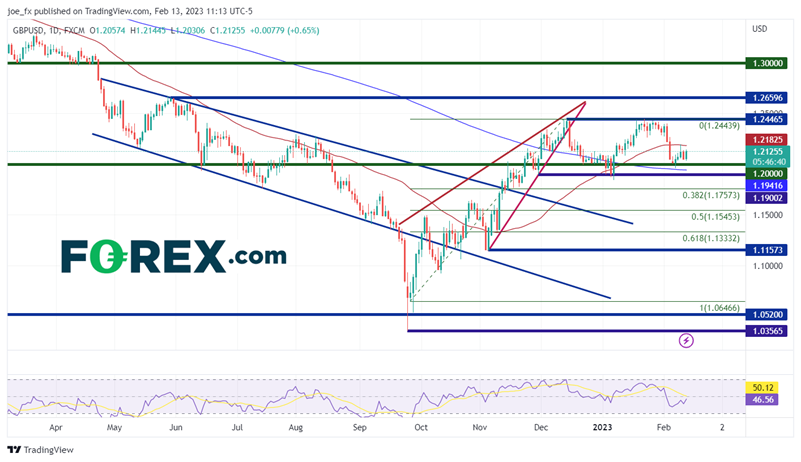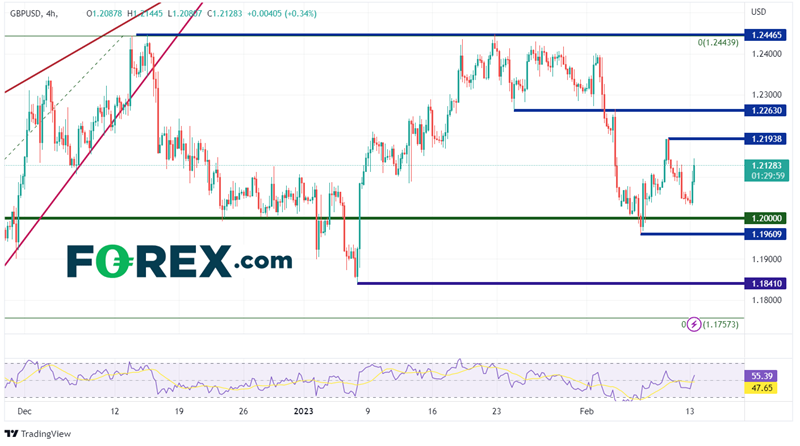Currency Pair Of The Week: GBP/USD

Photo by Colin Watts on Unsplash
Last week, the BOE’s Tenreyro said that she wouldn’t consider a rate cut where she is now, but can’t say at which meeting she would vote for this. However, BOE Governor Bailey and Chief Economist Pill were more hawkish noting that inflation is still too high. Finally, over this past weekend, the BoE’s Haskel said that he would prefer to make policy decisions with much more attention on the data flow over the next few months. A mix of comments from BoE officials, but Haskel may be the one who forms an opinion first as the UK releases Tier 1 data this week. On Tuesday, the UK will release its Claimant Count Change for January. The expectation is that the increase in people claiming unemployment will rise to 25,000 vs only an additional 19,700 in December. Average hourly earnings are also expected to creep higher. On Friday, the UK will release its January inflation data. Expectations are for January CPI to drop to 10.3% YoY vs 10.5% YoY prior. In addition, the Core CPI is expected to fall to 6.2% YoY vs a previous reading of 6.3% YoY. Finally, on Friday, the UK will release January Retail Sales. Expectations are for a fall of -0.3% MoM vs a previous reading of -1.1% MoM. Note that economists are expecting a five quarter recession, beginning in the current quarter. BoE members will have tough decisions ahead as they weigh hiking rates in a possible recessionary period.
There is one data point that matters to the US markets this week, and its US CPI due out on Tuesday. Expectations for the January print are for inflation to drop to 6.2% YoY vs a December reading of 6.5% YoY. This would be the lowest reading since October 2021. In addition, the Core CPI is expected to fall to 5.5% YoY vs a previous reding of 5.7% YoY. Although Fed Chairman Powell has pointed out in the past that PCE Core inflation is a more important to the Fed than the CPI when making Monetary Policy decisions, the CPI is an important data print for the markets. And a better or worse data print can cause volatility in the markets around the release. Last week, Powell spoke at the Economic Club of Washington and continued with the same message as that from the FOMC meeting the week prior. He noted that although the disinflationary process has begun, there will be a long, bumpy road ahead towards getting inflation down to the Fed’s 2% target. He cited the 517,000 jobs added to the economy in January as an example of this. Therefore, it leads one to believe that the Fed is data dependent as well. The US will also release Retail Sales at the end of the week. Expectations are for a drop of -0.3% MoM in January vs a horrible reading of -1% in December. Retail Sales ex-fuel is expected to be 0% vs December print of -1.1% MoM. CPI and Retail Sales data will be important economic releases for a Fed that is “data dependent”.
GBP/USD had been moving aggressively lower since the pair broke 1.3000 in late April 2022. Price moved lower in an orderly channel until late September 2022, when GBP/USD made an all-time low of 1.0357 on September 26th, 2022. The pair then moved higher in an ascending wedge formation to 1.2447. As price neared that apex, the pair moved lower but found support near the 1.2000 psychological round number level. The pair has been trading in a wide range between 1.1902 and 1.2448 since December 1st, 2022 as the 50-Day and 200-Day Moving Averages converge in the same area.

Source: Tradingview, Stone X
On a 240-minute timeframe, the two-and-a-half-month range is a bit clearer. There is a confluence of resistance just above at the 50-Day Moving Average (see daily) and the highs from February 9th at 1.2181/1.2194. Above there, GBP/USD can move to horizontal resistance at 1.2263, then the highs from January 23rd at 1.2448. However, if price moves lower, the first support is the lows from February 7th at 1.1960, then the 200 Day Moving Average (see daily) just below at 1.1942. Below there, price can fall to the lows of January 6th at 1.1841.

Source: Tradingview, Stone X
With UK jobs data, inflation data, and retail sales due out this week, along with US CPI and Retail Sales, this could be a volatile week for GBP/USD. The CPI data may be the most important as it will give markets an idea of what the BOE and Fed may consider next. But don’t be fooled, the other data may be just as important!
More By This Author:
Week Ahead: Inflation Data And News Of A BoJ Governor Successor
Once Again, Canada Blows Away Jobs Estimates
Riksbank Delivers A Hawkish Rate Hike



